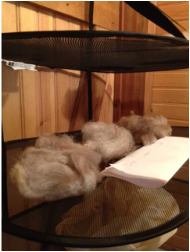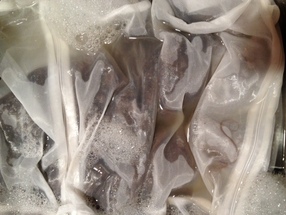I believe that spinning in the grease might not have been uncommon for breeds that are laden with lanolin. Much of the Icelandic wool I have cleaned had a nice hand before washing. Further, the process of washing makes the fleece prone to static which can disorganize fibers during a combing process, meaning oil needs to be added back in while working with the wool. If the wool was workable before washing, why would someone take make extra work for themselves?
Some fleeces, however, are indeed unctuous. I have a Shetland fleece that, even after a heavy wash, was still almost slimy to the touch. Soay is another that seems to be consistently greasy in the four samples with which I have worked.
When looking for period information on Viking era washing techniques, there is not much to go on. Penelope Walton Rogers mentions that at York there was no vegetable detergent found, but that there was a mineral similar to Fullers Earth (used later in time as a fulling agent for woven textiles). This fine clay has the ability to absorb oil, so I think it could be possible that it was used as a scouring agent.
In "The Roles of Pit Houses and Gendered Spaces on Viking-Age Farmsteads in Iceland", Milek (the author) states that in the pit houses (buildings used specifically for weaving) that urine was often stored on the eastern side of the structure. Stale urine was historically used as an agent in the process of both cleaning and dying wool (even up until the 20th century in some areas). So that is another option for cleaning.
While not Viking, there is an interesting reference nearby from a passage in "Capitulare de Villis" (a text that guides the way estates were governed during the reign of Charlemange) states that the women who worked in the communal weaving houses should be supplied the items they need to work their craft. "They are to supply the women's workshops with materials at the appropriate times, according to their instructions — that is, linen, wool, woad, vermilion, madder, wool-combs, teazles, soap, oil, vessels and the other small things that are needed there." The soap mentioned there could have been for use in scouring wool. (Perhaps I need to look more closely at the history of soap....)
After mulling this over, I contacted a wool vendor I regularly use and asked her for a couple of ounces of the greasiest wool she had. She sent me some California Red which was so exceptionally oily that it glistened (even though the wool, once cleaned, was actually quite dull). I weighed out a couple of small samples that were 7 grams each. The first I washed with Dawn dishwashing liquid in hot tap water, and then rinsed in hot water. The second I only soaked twice in hot tap water. The third I added to a bag of Fullers Earth, tossed it around and let it sit for the evening and then rinsed clean in warm, but not hot, water. After these processes were complete and the samples dried, all three weighed 5 grams. They all visually appear the same, but to the touch the one washed with dishwashing soap might be just a tad more clean (there seem to be faint traces of oil still in the other two). I would love to repeat this someday with larger portions of wool to get a better idea of how much grease really was washed out of each fleece sample. (Further, I would like to also compare it to processes such as a fermented suint method of scouring and use of stale urine at some point).
Of course, all of these thoughts about cleaning wool lead me to wondering what exactly it was that was used in period to add oil back in for combing and spinning. Clear fat/grease (that has been rendered) was referenced in one article I read as being a possibility. I have also seen mentions of rapeseed and, much past the SCA period, olive oil. I guess this is yet another thing to explore. ;-)


 RSS Feed
RSS Feed